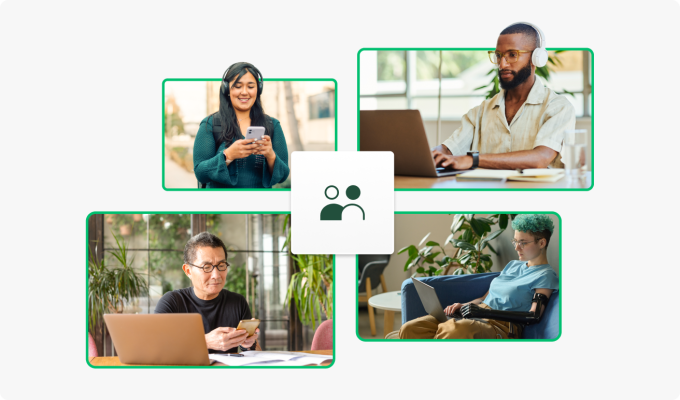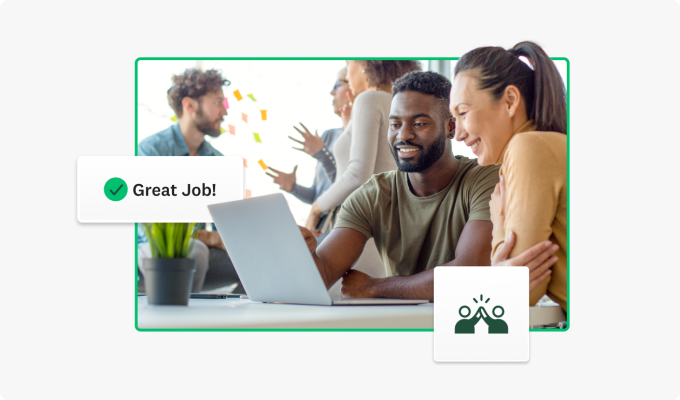30 employee engagement ideas to boost your team
Boost team morale, productivity, and satisfaction with these 30 actionable employee engagement ideas designed to inspire and empower your workforce.

Organizations often use strategic employee engagement to boost employee experience and support engagement. Engaged employees drive organizational success, leading to a 23% profitability rise and a 22% participation increase, according to the Gallup State of the Global Workplace 2024 Report.
We’ll share 30 expert engagement ideas you can use to improve engagement levels and show you how to measure the impact of your initiatives.
What is employee engagement?
Employee engagement refers to employees' emotional commitment to their organization and goals. Engaged employees view work as more than just a means to an end; they’re dedicated to the company's success.
Gallup’s research indicates that building highly engaged teams leads to fewer challenges, more positive results, and greater organizational success.
Why employee engagement matters
Companies with engaged teams are more likely to attract top talent and uphold a strong reputation. They excel at retaining current employees and benefit from a committed workforce.
Employees get to work at a business where they feel appreciated and are encouraged to succeed. Their successes create better conditions for their teams, customers, and employers.
Engaged employees also provide:
- A more efficient, productive workplace: Engaged teams benefit from a 10% increase in customer loyalty/engagement and an 18% increase in sales productivity.
- Improved risk management: Evaluation productivity increased by 14%, and quality defects decreased by 32%.
- Reduced turnover and increased loyalty: Teams benefit from an astounding 78% decrease in absenteeism and a 70% increase in wellbeing.
Conversely, low engagement is a lose-lose scenario. Gallup estimates low employee engagement costs the global economy 8.9 trillion U.S. dollars. Disengaged employees suffer from poor well-being and fail to achieve their full potential in the workplace.

30 actionable employee engagement ideas
Employee engagement activities are actionable strategies that organizations can implement to boost participation. Here are 30 different techniques for better engagement:
Recognition and rewards
Acknowledging and rewarding employee achievements reflects a genuine appreciation for their efforts. Only 36% of organizations implement an employee recognition program, highlighting significant room for improvement.
1. Employee of the Month programs
Employee of the Month (EOM) programs can motivate employees, improve morale, and support job satisfaction. Define clear eligibility criteria and offer personalized rewards, such as monetary incentives, public recognition, or development opportunities.
2. Peer recognition systems
Peer recognition involves employees acknowledging each other's contributions and achievements, fostering better relationships and a culture of equality. Encourage employees to send each other thank-you notes, shoutouts in meetings, or a "kudos" system.
Set clear objectives and encourage leadership to model recognition behaviors.
3. Cater team lunches after wins
The little things count. Catered lunches celebrate hard work and boost morale. To include remote employees, send gift cards for local delivery or fun meal kits. Alternatively, send cash or establish a lunch stipend.
Use the following catering ideas for in-person employees or ask them for their favorite spots:
- Vegan and non-vegan gourmet grilled cheese
- Local soups and sandwich spot
- Mediterranean with vegetarian options
- Cajun classics
- Seasonal eats (for example, thanksgiving-style meals)
- Authentic regional eats
- Poke day
- Classic pizza
4. Profit-sharing opportunities
This plan provides employees with a share of profits as a performance-based incentive. Profit-sharing can boost productivity and profitability, but it may not be a one-size-fits-all solution.
Implementation may need external support, and businesses must ensure consistent profitability, manage a working budget, pay off debts, and retain earnings.
Offer profit sharing based on a recognition system like tenure or work success.
5. Branded merchandise
This simple employee engagement idea is one small way to recognize a united, excited workforce. Hand out branded merchandise during a holiday, for a work anniversary gift, during onboarding, after a company win, or during a retreat.
We recommend choosing industry-specific or name-brand merchandise the employee wants to wear or use.

Team building activities
Use employee engagement surveys to gather feedback on team-building activities. The surveys should include data on what employees want to participate when free and how often they prefer to participate. These fun employee activities will build an excited, connected workforce.
6. Virtual team building
Virtual team building is an excellent way to include remote, hybrid, and in-person employees from the comfort of their respective workspaces. Engage employees with virtual escape rooms or guided workshops.
Encourage employees to develop relationships and provide opportunities to bond.
7. Outdoor retreats
Off-site and outdoor retreats may not be ideal for every organization. Be mindful of any financial or physical limitations. Offer inclusive activities that drive morale.
Activities could include:
- Nature-themes wellness retreat
- Campside cooler talks
- Outdoor BBQ (with meat alternatives)
- Egg drop competitions
- Tree planting
8. Bucket list activities
Your workforce may not be interested in a standard retreat. Unique experiences fulfill personal aspirations and create opportunities for bonding. Consider activities like cooking classes with renowned chefs or attending exclusive events as a group. These activities inspire excitement and build stronger teams.
9. Leadership networking
Networking coffee chats serve as a classic approach to business interaction. Organize these meetings with leadership team members. This concept does not constitute a formal mentorship program; it allows employees to engage directly with the organization’s decision-makers and pose their inquiries.
Regiment this idea with a small stipend and topic ideas to encourage a more casual, relaxed environment.
10. Holiday events
Work holiday events are excellent opportunities for cultural development and social cohesion. Successful and engaging events should be fun, inclusive, promote connection, and reinforce the company’s mission.
A well-done holiday event makes employees feel connected and supported by their organization.
Work-life balance initiatives
Quality work-life balance ideas help retain and engage employees. A study from the Harvard Business Review found that 63% of workers report needing more flexibility at work.
11. Flexible work hours
Flexible work schedules are crucial to increasing the representation of women and people of color in management. This work environment allows employees to manage their time more effectively without requiring heavily regimented time off requests. Employees can create their schedules and work when it suits them best.
Here are some examples of workplace flexibility:
- An employee leaves the office at 3:00 PM on Friday to pick up his children from school. He then finishes his work day from home.
- A manager with a light cold works from home for a few days while his cold frees up.
- An executive attends an in-person client meeting and then spends the rest of the day taking her mother to appointments. She catches up on missed work when she gets the chance.
These work-life benefits are often more effective than many popular equity programs in driving diversity in leadership. Flexible hours support employees in working when it's best for them, helping organizations retain diverse talent.
12. Remote work options
The McKinsey American Opportunity Survey highlights the growing demand for remote work in the U.S. 58% of workers have access to remote work, and 87% utilize it when offered. Flexible work arrangements improve productivity and reduce burnout for most employees.
Organizations can take advantage of remote work by adopting policies and balancing remote and on-site work to retain and satisfy top talent.
13. Flexible PTO
Flexible Paid Time Off (PTO) is a leave policy that allows employees to take time off for various personal needs—such as vacations, illnesses, or personal obligations—without being restricted to specific leave categories. Employees don't need to accrue the necessary days off to take off.
These policies vary in scope and requirements, but employees are almost always still responsible for their work despite time off. Flexible PTO fosters trust and reduces administrative burdens. The right policy boosts employee satisfaction while minimizing the pressure to use PTO before losing it.
14. Consider casual dress
A Gallup poll found that seven in 10 workers say their typical workplace attire is business casual or more dressed-down street clothes. Casual dress can alleviate stress, allow employees to relax at work, and give opportunities for self-expression.
Not all workplaces have this option. In many organizations, uniforms serve specific and necessary functions. In these cases, consider implementing a casual dress code during work events.
Learning and development opportunities
Professional development and learning opportunities boost employee engagement by 15% and improve retention rates by 34%.
15. Upskilling workshops
Upskilling workshops help employees enhance or develop new skills relevant to their roles or career growth.
While these skills may not be core competencies, they complement existing abilities and position employees for success. The workshops focus on technical proficiency, project management, and industry-specific expertise.
Upskilling workshops offer benefits like:
- Career advancement
- Employee retention
- Improved productivity
- Adaptability
16. Mentorship programs
Over 90% of employees with a mentor are satisfied with their jobs. Part of this statistic is related to the kind of person who seeks a mentor. Still, offering a systemized mentorship program can profoundly affect engagement.
Mentorship programs connect employees with seasoned professionals for guidance and career advice. They encourage personal development, create a supportive workplace culture, and help prepare employees for leadership roles.
17. Workshop stipends
Stipends are an excellent way to offer flexibility in self-investment. Employees can use this stipend to attend external workshops, seminars, or conferences.
18. Support Employee Resource Groups (ERGs)
Employee Resource Groups (ERGs) are voluntary, employee-led initiatives designed to create diverse, inclusive, and supportive workplaces.
ERGs focus on shared characteristics such as ethnicity, gender, or sexuality. These groups provide safe spaces for employees to connect and significantly contribute to engagement.
ERGs are vital in most Fortune 500 companies, and your organization should provide space, time, and a framework for them.
19. Initiate 360 performance reviews
360-degree performance reviews gather feedback from colleagues, direct reports, managers, and sometimes clients, providing a comprehensive evaluation of employee performance.
The process is a full-circle view of the employee's skills, behavior, and organizational impact. Employees are often more supported and receive a more holistic review in the 360 process.

Health and wellness programs
Recent Gallup research found that well-being can affect employee engagement. Healthy employees tend to be more productive and satisfied individuals.
20. On-site gyms
An on-site gym provides employees convenient access to fitness facilities, encourages regular exercise, and improves physical and mental well-being. Organizations can boost engagement by creating incentive programs, such as wellness challenges or discounted usage milestone memberships.
Integrating fitness into the workplace isn't always beneficial for every employee, but it can serve as an additional resource for those who need it.
21. Mental health support
Mental health support in the workplace is key for maintaining healthy and engaged employees. Luckily, there are plenty of ways to support mental health.
- Mental health training: Train managers to recognize distress signs and support employees. Use stress surveys and mental health calculators to gauge impact and guide action.
- Share mental health resources year-round to reduce stigma and improve access. Offer workshops and emphasize well-being in leadership communications.
- Offer innovative support: Mental health apps, access to free therapists, and time off for mental health appointments are all ways to support employees.
22. Health stipends
Health stipends are more than just financial support. They empower employees to invest in their wellness. Offer a range of financial stipends for:
- Fitness memberships
- Mental health support
- Wellness programs
- Health technology
- Nutritional stipends
- Preventive health
- Outdoor and active lifestyle
- Family wellness
- Alternative medicine
- Work-from-home wellness
Health stipends are personalized wellness support. Organizations can easily use them to cater to individual needs and promote holistic well-being.
23. Weekly office coffee walks
It sounds superficial, but a simple walk and talk between coworkers can do wonders for employee health. Set aside time for teams to step out of the office for a casual stroll and coffee to encourage connection and movement.
This activity builds camaraderie and provides a refreshing break from routine. Organizations can add themes or wellness discussions to make the walks more engaging.
Career development plans
Many employees want to advance their careers and receive on-the-job training and development. Creating innovative development initiatives keeps employees educated and engaged.
24. Promotions
Promotion and compensation are critical to employee engagement and retention. However, frequent promotions aren't necessarily the key; instead, integrate promotions into a reliable compensation program.
The process must be transparent, consistent, and appropriate to the employee's skills.
25. Leadership training
Leaders significantly impact organizational engagement. This particular engagement idea is beneficial: employees who attend training feel invested in and can use new skills to support their team.
A manager equipped to lead motivates team members and supports an engaged, fruitful workplace. This training can come in many forms, including:
- University certifications
- New leadership training
- Diversity-based leadership development
- Executive leadership support
26. Skills training
Skills training allows employees to grow and prepare for career advances. This initiative demonstrates the organization's commitment to professional development while ensuring the workforce remains competitive. Training opportunities can include:
- technical skills,
- industry updates,
- hard skill refinement,
- soft skills,
- or cross-functional training.
Before training, ask employees whether they prefer online courses, in-house workshops, or access to industry certifications. Ensure they have the tools to succeed and feel valued in their roles.
27. Support conferences
Conferences expose employees to new ideas and professional networks, fostering personal growth and job innovation through fresh perspectives. More importantly, they demonstrate that employee development is a priority, boosting loyalty and workplace morale.
Sponsoring conference attendance or providing stipends for travel and registration shows recognition and value for employees' contributions.
Corporate social responsibility initiatives
The Harvard Business Review found that "95% of employees believe businesses should benefit all stakeholders—not just shareholders— including employees, customers, suppliers, and communities they operate within." Use these employee engagement examples to drive your corporate social responsibility initiatives.
28. Volunteer days
Corporate volunteer programs are rising as organizations recognize their potential to boost employee engagement, productivity, and retention while strengthening community ties. Successful programs prioritize meaningful activities that:
- resonate with employees
- balance grassroots passion with structured corporate support
- and avoid common pitfalls like mandatory participation
Ideas like a community cleanup day, Habitat for Humanity build day, tree planting event, blood donation drive, youth mentoring day, or community garden planting are all excellent ways to volunteer on a team.
29. Sustainability projects
Corporate sustainability initiatives help companies reduce environmental impact while promoting social and economic progress. These initiatives are usually far-reaching and may involve every organization member.
Famous examples include:
- Chr. Hansen Holding’s focus on reducing food waste and eliminating antibiotics in animal production,
- Everlane’s recycled clothing line
- and Apple’s mangrove reforestation.
Your exact budget and goals will vary, but it's essential to convey that meaningful corporate sustainability starts with a commitment to change and empowering teams to take action.
30. Organization-wide DEI initiatives
Diversity, equity, and inclusion (DEI) initiatives are strategies, programs, and practices organizations implement to promote diversity, equity, and inclusion. The aim is to create environments where employees feel respected, valued, and empowered to contribute fully.
Creating strong DEI initiatives involves a five-step process:
- Awareness
- Compliance
- Tactical
- Integration
- Sustainable
Align fundamental strategies with DEI goals to foster inclusive cultures and engage all employees.
How to measure the success of employee engagement initiatives
Some of the above employee engagement ideas are perfect for your teams, but some may be less than ideal. Organizations need tools and strategies to track the effectiveness of their employee engagement efforts.
Employee satisfaction surveys and comprehensive feedback mechanisms are excellent ways to ensure your workforce aligns with your efforts. Surveys, particularly pulse surveys, provide insights into employees' thoughts and feelings about their roles and the workplace by getting to the core of their feedback.
Explore the different types of pulse surveys:
- Employee engagement pulse surveys track employee morale, motivation, and engagement with concise questions designed for regular check-ins.
- Career development pulse surveys assess satisfaction with training opportunities and identify ways to support employees' career growth.
- Relationships pulse surveys measure how well employees collaborate and pinpoint opportunities for improving teamwork.
- Work engagement pulse surveys gather insights on workplace morale, motivation, and satisfaction with job responsibilities.
- Culture pulse surveys evaluate employees' perceptions of workplace culture, including safety, job security, and alignment with organizational goals.
Job satisfaction surveys also allow you to assess employees' feelings toward their roles. Performance metrics like productivity and attendance, along with Key Performance Indicators (KPIs), are excellent indicators of program success.
It’s best to track employee KPIs continually. They provide valuable insights into employee satisfaction and its influence on organizational success. Monitor the following KPIs:
- Turnover rate: High turnover can reflect dissatisfaction. Monitoring trends helps identify and address retention issues.
- Employee absenteeism rate: Frequent absences may indicate disengagement or dissatisfaction, and a rising rate signals potential workplace morale concerns.
- Employee satisfaction index (ESI): This metric combines responses to key questions about job satisfaction, expectations, and alignment with ideal roles into an overall satisfaction score. It's a good overall KPI to use as a benchmark.

How to encourage long-term employee engagement
A one-time initiative is not enough to maintain long-term employee engagement. The key is to keep initiatives fresh and evolving based on employee feedback. Use the following concepts.
Continuous feedback
Continuous feedback fosters long-term employee engagement through a culture of open communication and trust. Feedback loops involve employees sharing their insights and the organization responding with actionable steps. This process demonstrates that employee opinions are valued.
Regularly collecting employee feedback through pulse surveys allows organizations to promptly address concerns, enhance workplace morale, and increase satisfaction.
Employee recognition
As previously mentioned, employee recognition programs keep employees engaged and can help attract and retain top talent.
- Retain talent: According to SurveyMonkey research, 63% of employees who frequently feel recognized at work are less likely to consider leaving their jobs within the next 3–6 months.
- Attract top talent: Compelling employee value propositions help your company stand out. Organizations that prioritize employee recognition enhance their employer branding and are more appealing to top-tier candidates.
Career advancement opportunities
You now know that building a world-class workforce requires providing excellent career advancement opportunities. Maintaining and innovating on existing programs is a must. Advanced survey analytics, partnerships with institutions, and a dedicated management team keep you competitive.
Fostering an inclusive culture
Maintaining an inclusive culture where employees feel valued boosts engagement. ERGs and DEI initiatives create safe spaces for employees to connect, grow, and contribute, empowering them to engage deeply with their work and community.
Employees who feel their perspectives are supported are more likely to commit to the organization’s mission. Companies can cultivate a motivated workforce by fostering inclusivity and amplifying diverse voices.
Launch effective employee engagement ideas
An engaged team enhances productivity and retention and fosters a sense of belonging. Intentional and fun employee engagement initiatives support this healthier workspace. Improving engagement is an ongoing process that requires adaptability, creativity, and commitment. Use employee feedback and let your data create an innovative and adaptable workforce.
Discover more resources

HR toolkit: Make employee experience your competitive advantage
HR leaders can use this toolkit to help drive exceptional employee experiences.

How feedback drives organizational transparency and builds trust
Support organizational transparency by making sure all stakeholders have access to relevant, honest information

eNPS Benchmarks: Measure and Improve Employee Engagement
Understand what makes a good eNPS, how to measure it, and discover effective strategies to increase employee engagement and retention.

Employee satisfaction: Why it matters and how to improve
Satisfied employees are happier and more productive. Learn how to measure and boost employee satisfaction to create a workplace people love.